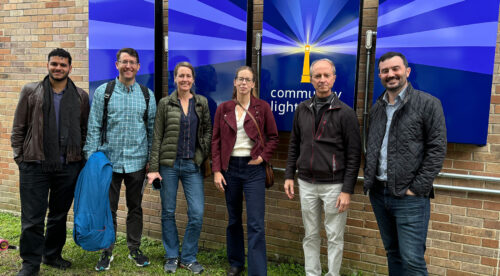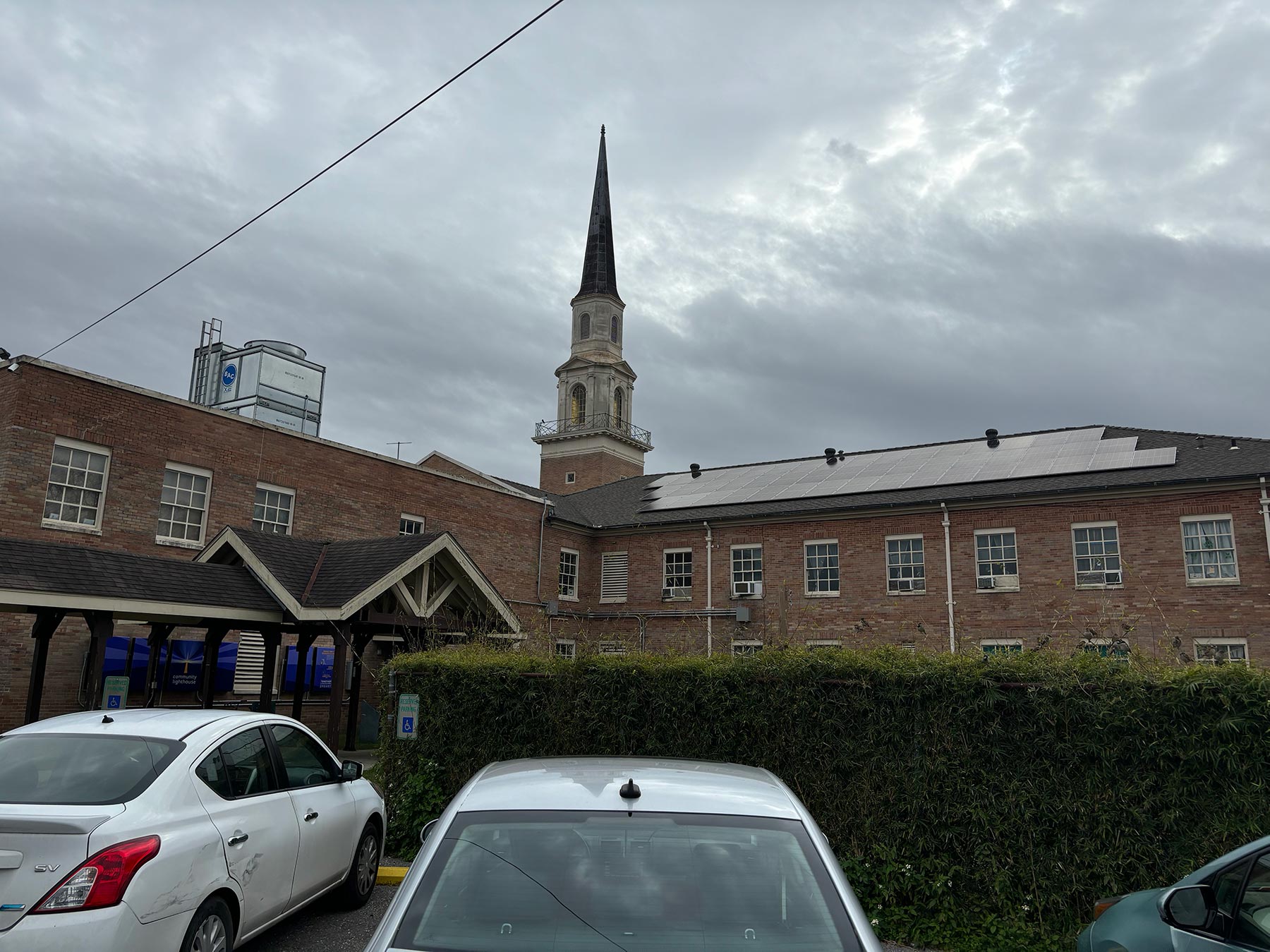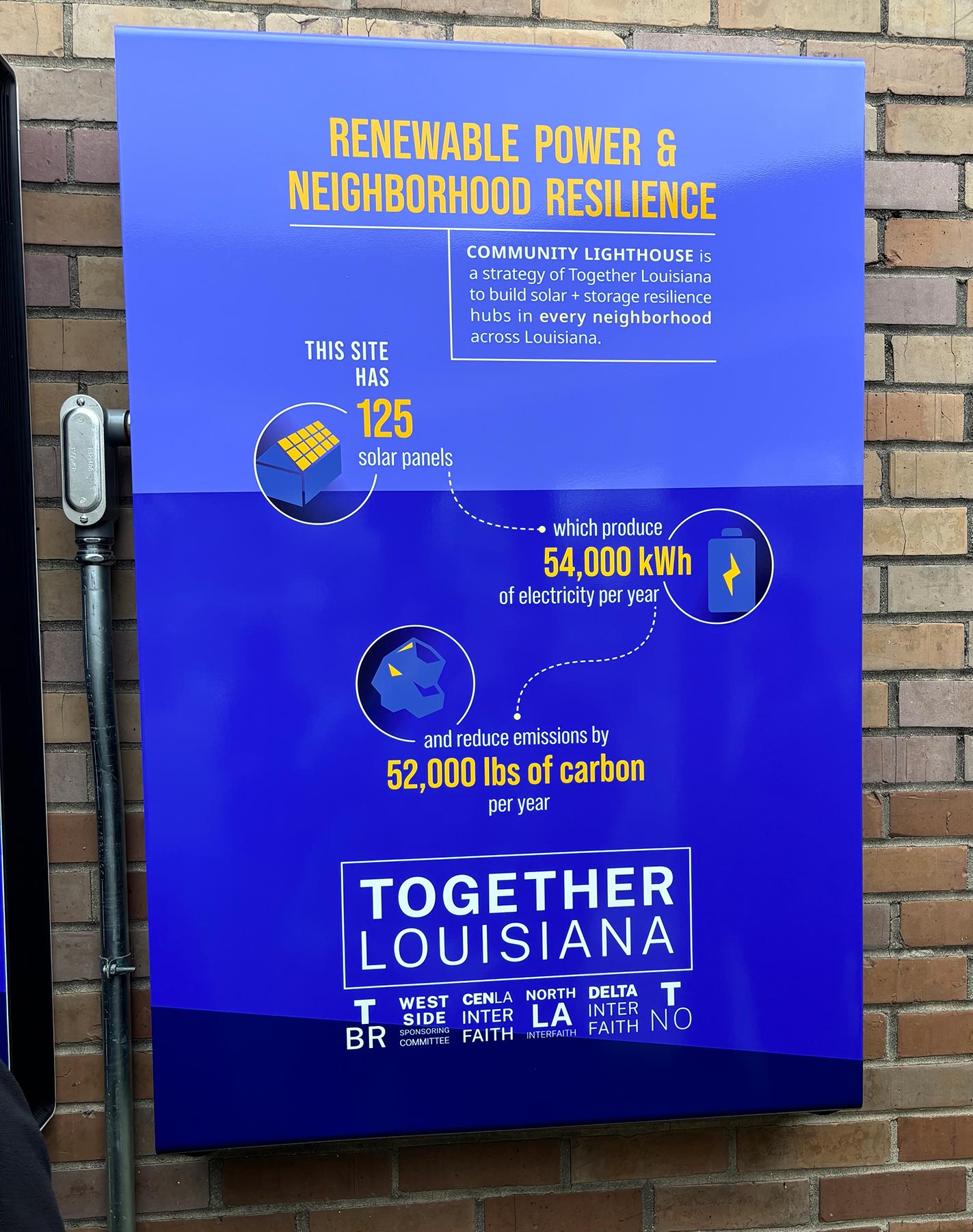
During a Historic Hurricane Season, Microgrids Kept Communities Running
Community projects from around the United States taught us five factors that can help greenlight your microgrid project.
When Hurricane Francine hit New Orleans this past September, cutting off power to almost half a million customers, many people had to figure out where to power medical devices, keep their medicine cool, and get a hot meal. Ronald Bailey, who relies on a machine to keep him breathing at night, and his wife Vera Lee solved those dilemmas by making the short trip to their neighborhood church. At the Grace United Methodist Church, they found an air-conditioned shelter with lights on, water, and — to their immense relief — a place to charge Mr. Bailey’s breathing machine.
Grace United is part of a network of Community Lighthouses born out of the experience New Orleans residents faced after Hurricanes Katrina and Ian. The Community Lighthouses are 10 community buildings, with more planned for the future, powered by solar and batteries and designed to provide essentials like power, air conditioning, water, meals, a community gathering space, and more when storms hit. Across the United States, communities are following the Grace United example and turning community centers into resilience hubs during increasingly frequent disasters that cause prolonged outages.
Solar-plus-battery-storage microgrids — which enable sites like churches, schools, universities, tribal council buildings, city halls, and more to generate, store, and utilize electricity either with or without access to the broader grid — are typically the first step to building a resilience hub as they provide reliable power when the grid goes out. What’s more, they benefit communities not only when storms roll in, but also when skies are clear, while simultaneously supporting local businesses and cutting pollution.

Building a microgrid is more appealing and more doable than ever before. Solar-plus-battery microgrids (unlike generators) are not susceptible to the fossil supply chain issues that hit Florida this past hurricane season. Solar and battery costs continue to decline, and non-taxable entities can take advantage of significant federal tax credits to help fund their project. But communities continue to face hurdles financing and implementing these complex projects, which require a significant time investment and decision-making on a range of topics from sizing a solar and battery system and building a capital stack to picking a contractor and developing a long-term operations and maintenance plan.
RMI’s Microgrid for Resilient Communities Cohort
To help communities overcome microgrid implementation challenges, RMI led a “Microgrids for Resilient Communities” cohort, a model that includes three modes of learning: members learning from each other, the RMI team learning from cohort members, and members learning from RMI’s direct experience. With a dozen leaders from churches, tribes, school districts, and historically black colleges and universities (HBCUs) across Iowa, Idaho, Georgia, Louisiana, Minnesota, New Mexico, and Washington, we offered support navigating design, financing, grants, operations and maintenance, and tax filings. We also provided direct technical analysis to help leaders determine a solar and battery system that was sized specifically to fit their needs. Each of these entities is working to build the first of several microgrids on their campus, tribal land, or broader community. One day, we hope to see a dozen more Community Lighthouse-type projects supporting these communities across the United States.
Supportive factors to greenlight your microgrid
Over the course of the cohort process, we learned more about what is needed to successfully implement a microgrid project in low-to-moderate income US communities. For other non-taxable entities looking to build a microgrid in their community, but unsure whether or how to move forward, below we provide five supportive factors to greenlight a project. When all are present, the project may result in financial savings on day one and the facility will be able to offer real support to a community in an outage.
1. Your building is already well positioned to serve as a community resilience hub
An effective community resilience hub should be able to provide essential services during emergencies while also having an existing relationship with community members, meaning that the facility is viewed as a familiar and accessible space for residents, particularly vulnerable ones. Ideal candidate facilities include schools, churches, libraries, or community centers that are already equipped to handle critical services. The facility will need to handle more visitors than usual for extended periods, and enhancements like added security, showers, or extra staffing may be needed to ensure the facility can support the community during a crisis. Facility leaders should also consider how they are going to manage an increase in demand for the facility services in a way that is fair to community members.
2. You have high electricity costs and favorable net metering policies
Facilities that already pay a high price for electricity will save more when those costs are offset by solar. For example, a facility that pays $0.17 cents per kWh compared to the national average of $0.13 would see higher savings.
Further savings accrue when net metering policies — the rate at which behind-the-meter solar is compensated for excess production — are favorable. Net metering policies that are financially favorable for your facility include: compensation at full retail rate, continuous monthly rollover of credits, and a capacity limit on project size that is at least 100 percent of building load (see a map of net metering rules here).
3. Your building is energy efficient (or can become so)
The more efficient a building is, the smaller the solar and battery system will need to be, lowering the up-front costs. If the building is not already energy efficient, energy efficiency should be the first step before starting to determine system size. While energy efficiency is not as shiny as a new panel or battery system, it is the same or more powerful dollar for dollar and can create dramatic impacts. For example, a shift to LED lighting can save 80 percent over traditional incandescent bulbs. While some contractors may not focus on this due to either lack of familiarity or the prospect of a lower cost from installing a smaller system, thankfully many utilities have programs that pay for energy audits.
4. You can afford the battery that you need
Sizing a battery is complex, and the right size depends on your resilience needs, the compensation you can receive for solar and battery power that’s sold back to the grid, and what you are willing and able to pay for. Fortunately, there are several options that can provide resilience in an outage while also being affordable, including the following:
- Size the battery for critical load where net metering rates are high. For those that can sell power back into the grid at a high rate and are in locations prone to frequent outages, the battery should be sized to power the “critical load” — the total load from equipment that is essential and must be maintained in an outage. This approach means less money is spent on the battery, which functions as an important insurance policy for when outages happen. During business-as-usual times, when solar is not available, the grid provides the site electricity so that the battery is ready to provide power in case of an outage.
- Size the battery for self-consumption if your net metering rates are low and/or peak shaving could help lower your overall bill. If compensation for selling power into the grid is low or net metering is not available in your area, the battery will likely need to be sized larger than the critical load and used to power your facility when the sun isn’t shining. This approach means that the up-front cost of the battery will be greater, but you can still achieve savings by avoiding purchasing power from the grid. This scenario is particularly cost-effective when the battery can be used for “peak shaving,” or to reduce the amount of energy you draw from the grid during times of peak demand on the electric grid. Many utilities offer some form of compensation to customers for peak shaving (e.g. reduced demand charges, demand response programs). With this scenario, because the battery is getting used more, it will degrade faster, so you should also plan for a shorter battery lifespan.
- Consider participating in a virtual power plant (VPP) program to save more money. Serving as part of a virtual power plant could create another revenue stream for the battery while also creating grid-wide resilience and customer savings. For example, in Vermont, customers of Green Mountain Power’s VPP receive low-cost batteries that power their homes during outages, and the utility can draw on those batteries when the grid experiences peak load (e.g., a summer heat wave). This avoids the need for GMP to purchase extremely expensive electricity and saves their customers money. Not all VPPs are designed alike, and more work is needed to determine how VPP business models should be set up to ensure that benefits are fairly distributed.
5. There are state, utility, or federal grant programs available to help finance your project
Projects eligible for significant federal, state, or philanthropic grants or tax credits will realize savings more quickly*. For the best monthly financials, facilities should pair grants or tax credits with low-cost finance options that support any remaining costs of your project. Some of the many exciting funding and finance options available today include:
- Investment Tax Credit: Nonprofits, tribes, universities, school districts, and local governments can now access the Investment Tax Credit (ITC), which can cover up to 30–70 percent of the cost for installing up to a 1 MW solar-plus-storage microgrid, with direct payments available.
- The Solar for All program serving your state, tribe, or multi-city/state region: Solar for All programs like Georgia BRIGHT’s “Community Benefit Solar” program may have funding to support community resilience hubs that pass savings on to low-income households, and other Solar for All programs could be designed similarly. Check with energy leaders in your state to find out whether your microgrid project could be supported by Solar for All.
- State and utility-led programs: Projects should investigate whether their state or utility offers programs that support microgrid deployment, like those run by the Texas State Energy Conservation Office, California’s Microgrid Incentive Program (MIP), Michigan’s Renewable Energy and Electrification Infrastructure Enhancement and Development Grant, and more.
- Other opportunities include:
- Rural Energy for America Program (REAP) – USDA
- Hazard Mitigation Grant Program (HMGP) – FEMA
- Working with local lenders such as community development financial institutions that have recently received Greenhouse Gas Reduction Fund grants to offer low-cost finance for clean energy investments
- Feasibility studies: Several of the funding programs listed above also offer funding for feasibility studies for solar + storage microgrids, including REAP, HMGP, MIP, and various state and utility-led programs. Organizations offering technical assistance include:
- National Renewable Energy Laboratory (NREL)’s Community Microgrid Assistance Partnership (C-MAP)
- Clean Energy Group (CEG)’s Technical Assistance Fund

So, you’re ready to move forward — now what?
Once you’ve selected a facility, feasibility studies are a critical first step in planning solar plus storage microgrid projects, helping stakeholders understand the technical, financial, and operational viability of the project. Once the feasibility study has been completed, projects will go through project planning (including utility engagement), procurement, contracting, installation, and final payments and interconnection before becoming fully operational.
As Ronald Bailey found when he was able to plug in his breathing machine at the local church, these systems can provide immense relief and stability for community members dealing with disaster. Considering the factors listed above can increase buy-in and financial savings for your project, paving the way for not just one but multiple solar-plus-storage microgrids to support your community.
Are you thinking about or working on a microgrid in your community and interested in connecting? We would love to hear more and are available at MCowart@rmi.org and MLiebman@rmi.org.
* Programs like this may be at risk if the US administration pulls back funding. RMI remains committed to advancing clean energy and driving emissions reductions in the United States and globally.